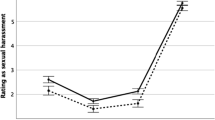Abstract
Male (96) and female (101) undergraduates (predominately white) described a typical workplace sexual harassment incident. Resulting scripts were content analyzed by male/female pairs of trained coders. Content analysis results showed a “blatant” harassment script involving stereotyped beliefs. Cluster analysis of judged coding gave a more detailed view of the “blatant” scripts as including a male superior harassing a younger, attractive female subordinate (often a secretary) in a private setting, involving a variety of behaviors, both severe (e.g., sexual propositions) and less severe (e.g., comments on physical appearance). Another rather large cluster characterized as “bantering” involved more public harassment in which multiple harassers treat a victim in an unprofessional way. Both clusters showed some subject sex differences in descriptions of behaviors considered as typical harassment, as well as of motive, and of victim response. Additional data collected after the Thomas-Hill hearings is presented.
Similar content being viewed by others
References
Aldenderfer, M. S., & Blashfield, R. K. (1984).Cluster analysis. Beverly Hills, CA: Sage Publications.
Bakeman, R., & Gottman, J. M. (1986).Observing interaction: An introduction to sequential analysis. New York: Cambridge University Press.
Cleveland, J. N., & Kerst, M. E. (1993). Sexual harassment and perceptions of power: An underarticulated relationship.Journal of Vocational Behavior, 42, 49–67.
Collins, E. G. C., & Blodgett, T. B. (1981). Sexual harassment: Some see it ⋯some don't.Harvard Business Review, 59, 77–95.
Diekhoff, G. (1992).Statistics for the social and behavioral sciences: Univariate, bivariate, multivariate. Dubuque, IA: Wm. C. Brown.
Equal Employment Opportunity Commission. (1980). Interpretive guidelines on sexual harassment.Federal Register, 45, 74677.
Everitt, B. (1979). Unresolved problems in cluster analysis.Biometrics, 35, 169–181.
Farley, L. (1978).Sexual shakedown: The sexual harassment of women on the job. New York: McGraw-Hill.
Fitzgerald, L. F., & Shullman, S. L. (1993). Sexual harassment: A research analysis and agenda of the 1990'sJournal of Vocational Behavior, 42, 5–27.
Gagnon, J. H. (1977).Human sexualities. Glenview, IL: Scott, Foresman.
Gioia, D. A., & Poole, P. P. (1984). Scripts in organizational behavior.Academy of Management Review, 9, 449–459.
Gutek, B. A., Morasch, B,. & Cohen, A. G. (1983). Interpreting social-sexual behavior in a work setting.Journal of Vocational Behavior, 22, 30–48.
Gutek, B. A. (1985).Sex and the workplace. San Francisco: Jossey-Bass.
Heider, F. (1958).The psychology of interpersonal relations. New York: Wiley.
Horgan, D. D., & Reeder, G. (1986). Sexual harassment.AAOHN Journal, 34, 83–86.
Jones, E. E., Kanouse, D. E., Kelley, H. H., Nisbett, R. E., Valins, S. E., & Weiner, B. (1972).Attribution: Perceiving the causes of behavior. Morristown, NJ: General Learning Press.
Kidder, L. H. (1981).Selitz, Wrightsman, and Cook's research methods in social relations (4th ed.). New York: Holt, Rinehart & Winston.
McCormick, N. B. (1987). Sexual scripts: Social and therapeutic implications.Sexual and Marital Therapy, 2, 3–27.
Medea, A., & Thompson, K. (1974).Against rape. New York: Farrar, Straus, & Giroux.
Meritor Savings Bank v. Vinson, 106 S. Ct. 2388, 1986.1.
Norusis, M. J. (1988).SPSS-X Advanced Statistics Guide (2nd ed.). Chicago: SPSS.
Padgitt, S. C., & Padgitt, J. S. (1986, January). Cognitive structure of sexual harassment: Implication of university policy.Journal of College Student Personnel, pp. 34–39.
Popovich, P. M., Gehlauf, D. N., Jolton, J. A., Somers, J. M., & Godinho, R. M. (1992). Perceptions of sexual harassment as a function of sex of rater and incident form and consequence.Sex Roles, 27, 609–625.
Popovich, P. M., Licata, B. J., Nokovich, D., Martelli, T. M., & Zoloty, S. (1986). Assessing the incidence and perceptions of sexual harassment behaviors among American undergraduates.The Journal of Psychology, 120, 387–396.
Pryor, J. B. (1985). The lay person's understanding of sexual harassment.Sex Roles, 13, 273–286.
Ryan, K. M. (1988). Rape and seduction scripts.Psychology of Women Quarterly, 12, 237–245.
Shank, R. C., & Abelson, R. P. (1977).Scripts, plans, goals, and understanding. Hillsdale, NJ: Lawrence Erlbaum Associates.
Schneider, B., Wheeler, J. K., & Cox, J. F. (1992). A passion of service: Using content analysis to explicate service climate themes.Journal of Applied Psychology, 77, 70–716.
Taylor, S. J., & Bogden, R. (1984).Introduction to qualitative research methods (2nd ed.). New York: John Wiley & Sons.
Till, F. J. (1980).Sexual harassment: A report on the sexual harassment of students. Washington, DC: United States Government printing Office.
Terpstra, D. E., & Cook, S. E. (1985). Complainant characteristics and reported behaviors and consequences associated with formal sexual harassment charges.Personnel Psychology, 38, 559–574.
Trevino, L. K. (1992). The social effects of punishment in organizations: A justice perspective.Academy of Management Review, 17, 647–676.
United States Merit Systems Protection Board (USMSPB). (1981).Sexual harassment in the federal workplace: Is it a problem? Washington, DC: U.S. Government Printing Office.
Author information
Authors and Affiliations
Rights and permissions
About this article
Cite this article
Popovich, P.M., Jolton, J.A., Mastrangelo, P.M. et al. Sexual harassment scripts: A means to understanding a phenomenon. Sex Roles 32, 315–335 (1995). https://doi.org/10.1007/BF01544600
Issue Date:
DOI: https://doi.org/10.1007/BF01544600



